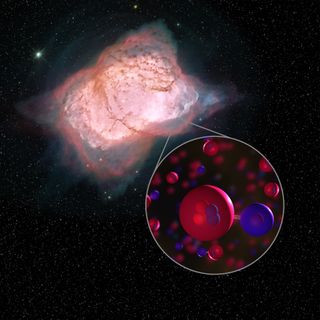A flying observatory has pinpointed the first type of molecule that formed in the universe after the Big Bang.
Helium hydride — a combination of helium and hydrogen — was detected roughly 3,000 light-years from Earth by NASA's Stratospheric Observatory for Infrared Astronomy (SOFIA). The molecule was found in a planetary nebula, NGC 7027, which is the dusty remnant of a sun-like star.
For hundreds of thousands of years after the Big Bang, the universe was too hot and too full of radiation for atoms to bond together. At that time, only a few types of atoms existed, including hydrogen, helium and lithium. However, the new study shows that 100,000 years after the Big Bang, the universe cooled enough for helium and hydrogen to combine, forming the molecule known as helium hydride.
Related: The Universe: Big Bang to Now in 10 Easy Steps

Scientists have detected the universe's first molecule, helium hydride, in a distant planetary nebula called NGC 7027.
While helium hydride has been produced and tested in a laboratory setting, this discovery marks the first time that the molecule has been detected in space — which sheds light on the chemistry of the early universe, according to a statement from NASA.
"This molecule was lurking out there, but we needed the right instruments making observations in the right position — and SOFIA was able to do that perfectly," Harold Yorke, director of the SOFIA Science Center in California's Silicon Valley, said in the statement.
Once the universe cooled down, hydrogen atoms started to interact with helium hydride, creating molecular hydrogen, which set the stage for star formation. From that point on, stars created the other elements of the cosmos, according to the statement.
"The lack of evidence of the very existence of helium hydride in interstellar space was a dilemma for astronomy for decades," Rolf Guesten, lead author of the study from the Max Planck Institute for Radio Astronomy in Bonn, Germany, said in the statement.
NGC 7027 has been a location of interest for helium hydride since the late 1970s. Ultraviolet radiation and heat from the aging star led scientists to believe that its environment would be suitable for helium hydride to form. However, astronomers were unable to confirm this theory until now.
The SOFIA instrument is a telescope that is flown on a Boeing 747-SP airplane at up to 45,000 feet, where its observations are not impacted by interference from Earth's atmosphere. SOFIA returns to Earth after every flight, allowing scientists to regularly update the instrument with the latest technology. One of the most recent upgrades included adding a specific channel to detect signatures of helium hydride, which previous telescopes did not have.
"This flexibility allows us to improve observations and respond to the most pressing questions that scientists want answered," Naseem Rangwala, SOFIA deputy project scientist, said in the statement.
Their findings were published April 17 in the journal Nature.
Follow Samantha Mathewson @Sam_Ashley13. Follow us on Twitter @Spacedotcom and on Facebook.
https://www.space.com/astronomers-detect-universe-first-molecule-space.html
2019-04-18 16:00:00Z
52780270966522
Bagikan Berita Ini














0 Response to "Astronomers Finally Spot Universe's First Molecule in Distant Nebula - Space.com"
Post a Comment